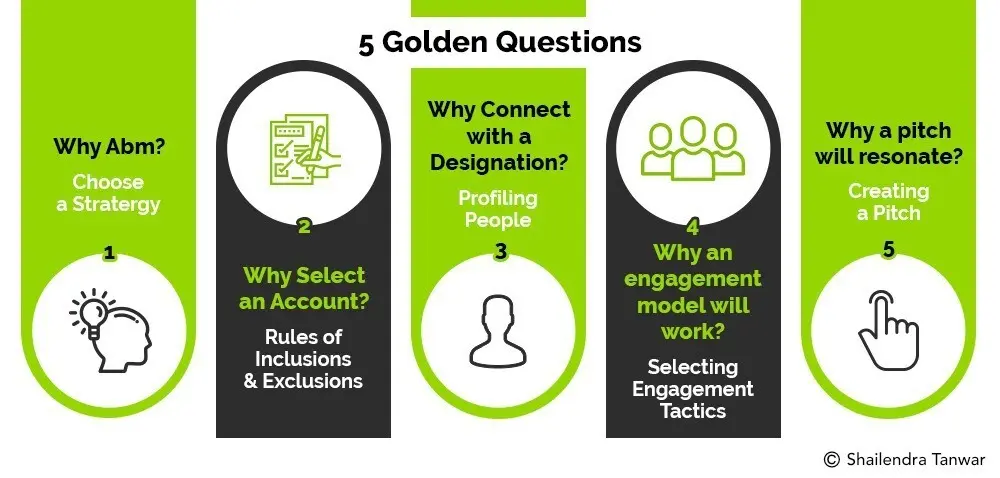
My musings on ABM - The 5 golden questions
In my two decades of diverse industry experience, I got acquainted and subsequently fascinated with Account Based Marketing, and since then I have been a student of ABM, trying to gain in-depth knowledge this approach of B2B/ Enterprise Marketing. It was back in 2000 that my brush with ABM was a pure co-incidence. I then started getting acquainted with practical aspects of ABCs of marketing (let alone ABM) and was assigned the task to sell engine oil to large fleet owners (like Key/Top/ Focus Accounts for a B2B business). Very soon with inputs from distributors, dealers, & sales leads databases were readied, and I hit the ground with great vigour. Within no time I was running multiple activation campaigns, delivering quick increase in sales. But that didn't last long. And soon we moved to other strategies to achieve the sales numbers.
Today when I look back, I feel the objective of 'increase sales & penetrate fleet segment' may have been too broad & maybe even vague. There could have been a few more rules defined to the strategy. Questions could have been asked, debates should have been done on why a territory and why not other. Campaign testing could have been done before venturing into action.
Surprisingly though, even today the most recommended 1st step on ABM in many articles/ blogs, is 'list target accounts'. The identification is generally based on judgment of sales leaders or recommendations of partners. What we skip is asking a few questions to understand what we want to achieve, who will help us achieve this & why will they help us. Though strenuous, this exercise of asking a few WHYs reduces the risks of failure, OR shall I say, improves the chances of succeeding.
These WHYs are generally around
1. Why ABM approach? - Step of 'choosing ABM over other strategies' to achieve business goals.

Take the path only if (a) Your organization offers product(s) with feature(s) that serves to 'particular type of companies' from a 'countable verticals'. If you can't count the verticals on a hand, and view the account list in single view of excel sheet, don't spend time on ABM, but maintain a generic demand generation or customer engagement strategy.
(b) These accounts will respond more positively if focussed upon, by engaging selected people (or departments), over multiple occasions with a customized pitch Nail this before even going to the 2nd WHY.
2. Why an account(s) would be picked? - Step of 'defining rules of inclusions & exclusions'.
This step is of doing an in-depth profiling of verticals & accounts'. Spend time on understanding challenges & trends in target industries; refer to journals, research reports, and annual reports. Take help from research agency, if needed, and get all the answers. The temptation of adding an account or vertical will creep in, but refrain and stay focussed, at least during the initial go.
3. Why we need to talk to a designation or persona and not others?- Step of 'Profiling key people'
ABM is all about right targeting. Selecting a wrong profile is as disastrous as targeting a wrong vertical or account. This step is to separate Decision Makers from Influencers and Users. Each plays a distinct & important role in evaluation, recommendation, finalization and post purchase feedback.
4. Why a mode of engagement will work & with whom? - Step of 'selecting engagement models'.
Interactions with Influencer, Decision Maker & User come at different stages of sales cycle, and each of these profile may prefer a different method of engagement. For example, an evaluator could be engaged through a webinar, but maybe not the decision maker, who will need a 1o1 discussion. At times some of these entities are not even in customer premise. For example the set up could be outsourced to a BPO/KPO and the user group is there, OR it could be an analyst firm that evaluates & influences purchase. The earlier these details are scoped in, the better it is for success of the strategy.
5. Why a particular pitch/messaging/ campaign will resonate? - Step of 'creating a targeted pitch'.
Content is key in ABM, & that's what you create here. Start with listing of points the makes your message as panacea to a challenge that customer is facing. This will come by analysing the facts around the challenges & the gaps which are perceived to exist. Part of this is answered in Step 1 to Step 4. Now is time to document all that. Is the customer facing issues around a process, productivity, rising costs, compliance with government policies, or even exit of a current vendor. Depending on the reasons identified, you can create a precise pitch, select tools of engagement, test both and then execute. Remember to create a customized pitch and engagement method for influencer, decision maker & user.

There would definitely be more WHYs and HOWs which should be raised before selecting an account(s)or getting in an ABM approach. With the collective wisdom that sales, operations, pre-sales, and marketing teams have in organizations, unlikely that ABM will see an ill fate. In my opinion, it is by far the best way of doing Marketing, It brings the much needed SCIENCE to THE ART OF MARKETING.
In my next article I will share views on the 2nd challenge we all face in ABM. 'How to overcome the Challenge of Sustainability'
My musings on ABM - The 5 golden questions
With 20 years of industry experience, an understanding of the nuances of Account-Based Marketing (ABM) has emerged, emphasizing targeting specific accounts rather than broad audiences. Early experiences highlighted the importance of asking strategic "WHYs": why choose ABM over other strategies, why target specific accounts, and why engage certain personas. These questions are crucial for crafting effective campaigns, aligning with business goals, and improving the likelihood of success by focusing on tailored engagement and precise messaging.
Shailendra Tanwar
Director
April 23, 2019






